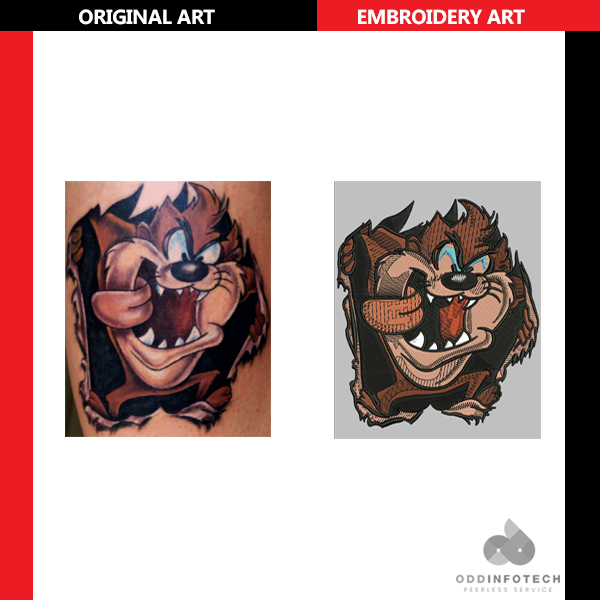Project Description
Embroidery has been an art form that has stood the test of time. From intricate designs adorning royal garments to personalized patches on denim jackets, embroidery has a unique charm that captivates hearts. But in today’s digital age, the art of embroidery has evolved. With the advent of technology, converting images to embroidery digitizing has opened up a whole new world of possibilities.
Understanding Embroidery Digitizing
Embroidery digitizing is the process of converting artwork or images into a digital embroidery file that can be read by an embroidery machine. This technology allows for precise stitching, intricate details, and vibrant colors, bringing your designs to life with stunning accuracy.
The Transformation Process
Image Selection
Begin by choosing an image that inspires you. Whether it’s a photograph, illustration, or graphic design, select something that speaks to your creative vision.
Digitizing Software
Invest in quality digitizing software that allows you to convert your image into stitches. Popular options include Wilcom, Hatch, and Embrilliance.
Digitization Process
Using the software, trace the outlines of your image and assign stitch types, colors, and densities. This step requires careful attention to detail to ensure the final embroidery is true to the original design.
Testing and Adjustments
Once digitized, test the design on scrap fabric to identify any areas that may need adjustments. Fine-tune stitch settings, thread colors, and other parameters until you’re satisfied with the result.
Embracing the Digital Transformation
In the past, the process of turning an image into an embroidery design was painstakingly manual. Skilled artisans would meticulously trace the contours of an image onto fabric, translating it into stitches by hand. However, this method was not only time-consuming but also limited in its precision.
Today, with the advancement of technology, the process has been revolutionized. Using specialized software, images can now be converted into embroidery digitizing with unparalleled accuracy. This digital transformation has streamlined the process, making it more efficient and accessible to a wider audience.
The Magic Behind the Scenes
So, how does the magic of image to embroidery digitizing happen? It all starts with a high-quality image. Whether it’s a company logo, a beloved pet’s portrait, or a scenic landscape, the possibilities are endless. Once the image is uploaded into the digitizing software, the real magic begins.
The software analyzes the image, breaking it down into individual stitches, colors, and patterns. Every pixel is meticulously mapped out, ensuring that the final embroidery design is a true representation of the original image. This intricate process requires both technical expertise and artistic flair, as the digitizer fine-tunes every detail to perfection.
Unlocking Creativity
One of the most exciting aspects of converting images to embroidery digitizing is the endless creative possibilities it offers. No longer bound by the constraints of traditional embroidery techniques, designers can now experiment with a wide range of styles, textures, and effects.
From vibrant colors to subtle shading, the digital realm allows for unprecedented flexibility and customization. Whether you’re looking to create bold statement pieces or delicate heirlooms, embroidery digitizing empowers you to bring your vision to life with unparalleled precision.
Seamlessly Integrating Technology
In today’s fast-paced world, efficiency is key. Embroidery digitizing not only allows for greater creativity but also streamlines the production process. With the click of a button, designs can be replicated, resized, and edited to meet the demands of any project.
Whether you’re a small business owner looking to create custom merchandise or a hobbyist seeking to add a personal touch to your creations, image to embroidery digitizing offers a seamless solution. By harnessing the power of technology, you can elevate your embroidery game to new heights and unlock the door to success.
Overcoming Challenges and Embracing Growth
Patience and Perseverance
Like any form of art, embroidery digitizing requires patience and perseverance. Don’t be discouraged by setbacks or mistakes; instead, use them as learning opportunities to grow and improve your skills.
Embracing Imperfections
No embroidery design is perfect, and that’s what makes each piece unique. Embrace the imperfections, quirks, and nuances of your creations, knowing that they’re a reflection of your journey as an artist.
Benefits of Embroidery Digitizing
Versatility
With embroidery digitizing, you can embroider almost any design imaginable, from intricate logos to detailed portraits.
Customization
Digitizing allows you to customize your designs to suit your preferences, whether it’s adjusting colors, resizing, or adding text.
Professional Results
Digitized embroidery designs have a polished and professional appearance, making them perfect for businesses, gifts, and personal projects.
Conclusion: A Tapestry of Success
In conclusion, converting images to embroidery digitizing is not just a practical solution; it’s a journey of creativity and innovation. By embracing technology and pushing the boundaries of traditional embroidery, you can unleash your imagination and create truly remarkable designs.
So, whether you’re a seasoned embroiderer or a curious novice, don’t hesitate to explore the world of embroidery digitizing. With the right tools and a dash of creativity, you can transform ordinary images into extraordinary works of art and pave your way to success in the digital age.
Frequently Asked Questions (FAQs)
What is embroidery digitizing, and how does it work?
Embroidery digitizing is the process of converting an image into a digital embroidery file that can be read by an embroidery machine. It involves mapping out stitches, colors, and textures to recreate the original image with precision and detail.
Which software is best for embroidery digitizing?
Popular embroidery digitizing software options include Wilcom, Pulse, and Hatch Embroidery. Each offers unique features and functionalities to suit different needs and preferences.
What factors should I consider when selecting an image for digitizing?
When selecting an image for digitizing, prioritize high resolution, clear outlines, and distinct features. These qualities ensure optimal digitization results and high-quality embroidery designs.
How can I improve my stitch selection for embroidery digitizing?
Experiment with different stitch types, lengths, angles, and densities to add depth and dimension to your embroidery designs. Practice regularly and explore new techniques to refine your skills.
Can I digitize any image for embroidery?
While many images can be digitized for embroidery, it’s essential to choose images with clear outlines and distinct features for the best results. Complex images may require additional editing and optimization for successful digitization.
What are some tips for beginners in embroidery digitizing?
Start by familiarizing yourself with embroidery digitizing software and basic stitching techniques. Practice digitizing simple images before tackling more complex designs, and don’t be afraid to experiment and learn from your mistakes.


